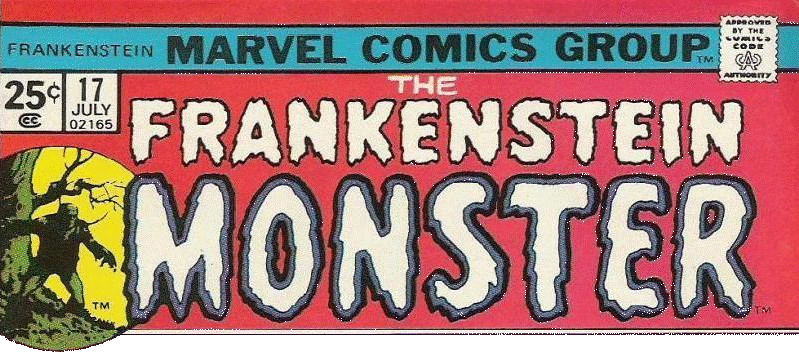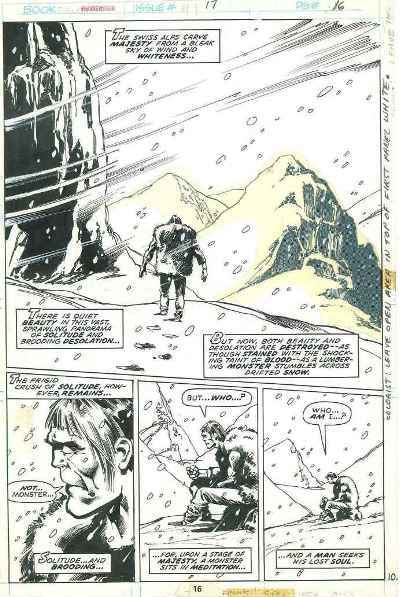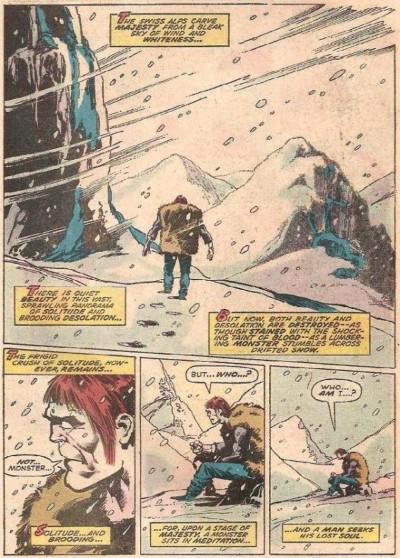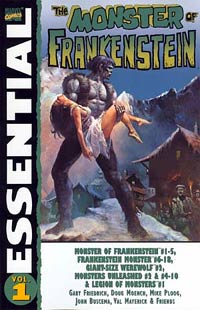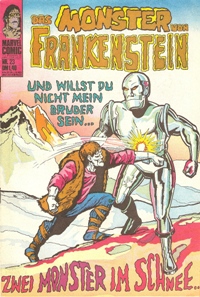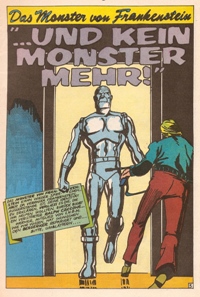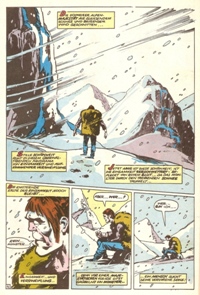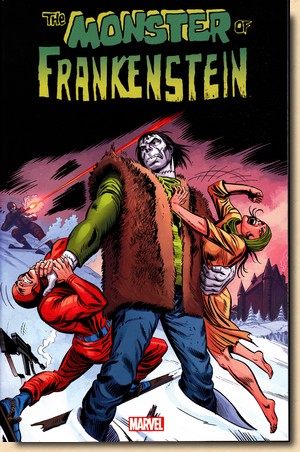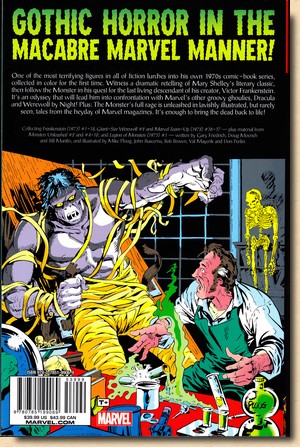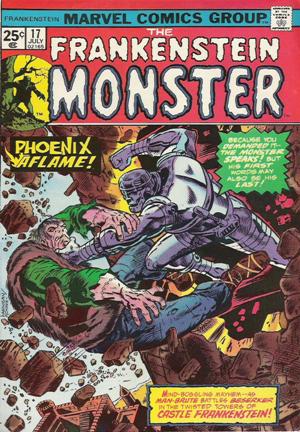
Frankenstein Monster #17
(July 1975)
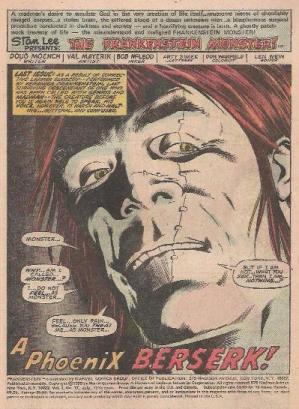
|
|
Upon
arrival of the trio, the benevolent Veronica
Frankenstein, who hired Prawn to find the
Monster, then performed surgery on its damaged
larynx amidst an ongoing attack from I.C.O.N. -
"International Crime Organization
Nexus". Frankenstein Monster #17 opens with a
recap regardingt the Monster's restored ability
to speak and how this came about in the previous
issue.
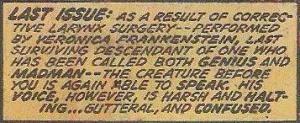
The first words uttered by
the Monster reveal the topic foremost on its mind
- the question of its identity:
"Monster...
why... am I called... Monster? I... do not
feel... as Monster... feel... only pain...
because you treat me... as Monster... but if
I am not... what you say... then I am...
nothing?"
Partly a reaction to having
been called a hero by Caccone for bringing down
I.C.O.N.'s prime weapon, an android called
"Berserker", at the end of the previous
issue, the Monster is evidently both highly
preoccupied and confused, as it concludes with a
logic as sharp as a cold knife:
"And... if I am
nothing... then I should not be here... or
alive."
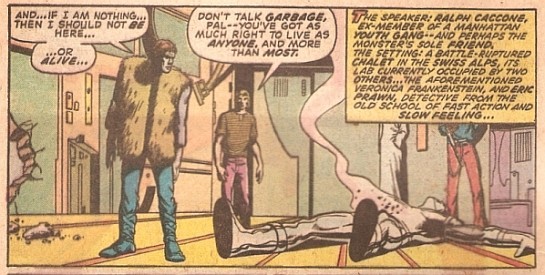
|
|
| |
| Although
Prawn and Caccone are both surprised and somewhat
overwhelmed by the directness and the weight of the
Monster's first utterances, they both assure the Monster
that it has both a right to live and indeed a place in
life - not the least, as Caccone points out, thanks to
having saved their lives by short-circuiting the
Berserker when he attacked the group. This, however,
provokes more ponderings on behalf of the Monster as it
feels that it has actually killed the android and wonders
whether in fact killing is its purpose and the true
reason for its life. Currently unnoticed, the
I.C.O.N. helicopter carrying agents "Indigo"
and "Cardinal" - who coordinated the previous
attack - is still circling the Frankenstein residence
(which is referred to as a "chalet" but whose
structure resembles a castle more than anything else),
and the two codename operatives are heatedly debating the
options following the deactiviation of the Berserker.
Upon contacting "Rainbow", the head of
I.C.O.N., they receive instructions to contact the
organisation's undercover man inside the Frankenstein
residence, Werner Schmidt, and have him repair the
android.
Meanwhile,
Schmidt tries to secure his cover with Veronica
Frankenstein and the guests by explainig his absence
during the first wave of attacks on the residence (when
he was, in fact, aiding the incoming I.C.O.N. fighters)
with a story of having been trapped and unarmed. Veronica
is beginning to have some doubts but decides to postpone
any further discussions - including notification of the
local authorities - to later on.
|
| |
| Left behind alone in the
laboratory, Schmidt ponders the motionless
Berserker stretched out on the floor when he
becomes aware of flashes of light coming through
the window from the outside and realizes that
Indigo and Cardinal are contacting him by means
of Morse code from the hovering helicopter.
Schmidt replies using a scalpel to reflect the
sunlight and thus quickly receives and confirms
his orders and immediately sets to work. Elsewhere
in the isolated building, Veronica Frankenstein,
Caccone, Prawn and the Monster have obviously
continued the discussion on the topic of identity
and have now reached the question of where Victor
Frankenstein procured the brain for his creation.
The Monster seems determined to find out, but
Caccone cautions its hopes by pointing out that
the Monster obviously cannot recall any details
from the brain's "previous life", not
even a name. The discussion is, however, rendered
academic by Veronica's statement that she has
searched all remaining files and documents of
Victor Frankenstein, including his personal
diary, without finding the slightest hint.
|
|
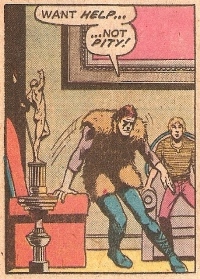
|
|
| |
| In
fact, it even seems that all information on her
ancestor's work on the Monster seems to have vanished
completely. Veronica Frankenstein deplores the fact that
she cannot offer any real help to the Monster's quest for
its identity but offers empathy and consolation instead. |
| |
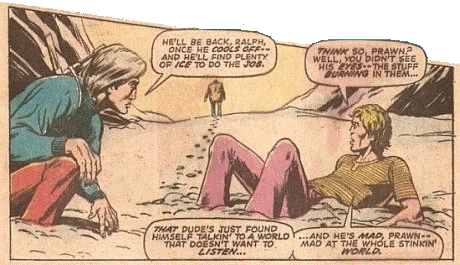 |
|
The Monster, however, is
enraged; it seeks help, not pity, and as there
seems to be no hope nor chance for help from this
group of people, the Monster leaves and wanders
out into the snow covered Swiss Alps. Caccone
storms out in pursuit, intending to stop the
Monster and have it turn back, but is brushed
aside and realizes not only that he has no means
of standing in the way of the Monster but also
that there would be no purpose in doing so for,
as he tells Prawn, the Monster is simply mad at a
world that just won't listen.
|
|
| |
| As
the snow continues to fall, the Monster just keeps on
walking and stumbles out into the wide and glaring
whiteness of the Swiss Alps, all the while troubled by
the thought of its true nature. If, as Caccone and the
others have clearly stated, he is no Monster - then just
exactly who is he? Back in the fortified
Frankenstein residence, Schmidt is approaching the final
working steps in his attempt to reactivate the Berserker,
whilst Veronica Frankenstein, Caccone and Prawn are
deliberating whether or not to go after the Monster.
|
| |
| The increasing snowfall,
however, poses a problem, and finally Veronica
suggests to wait a little longer in the hope that
the Monster will return by itself and otherwise
to organise a search party later on, lead by
Schmidt. However, the I.C.O.N. agent
inside the solitary building is preoccupied with
entirely different things at that very moment, as
he signals to the helicopter that he has done all
that he could to restore the Berserker's
functionality again - and that he fears that his
cover will be blown if the android should indeed
become operational again. Cardinal and Indigo
agree to pick him up without delay, and as
Schmidt makes a run for it, the Berserker comes
back to life and starts to search the building in
order to meet his sole objective: capture the
Frankenstein Monster...
|
|
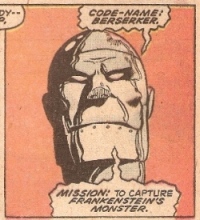
|
|
| |
| The android
quickly runs into Veromica Frankenstein, Caccone and
Prawn. As the latter puts up a short and utterly futile
resistance by firing at the Berserker, Caccone is quick
to inform the metal behemoth that the Monster is no
longer with them and has ventured out into the snow. As
the Berserker turns to follow, the I.C.O.N. helicopter is
by now running low on fuel and will need to return to
base - leaving the android to home in on his target as
programmed... |
| |
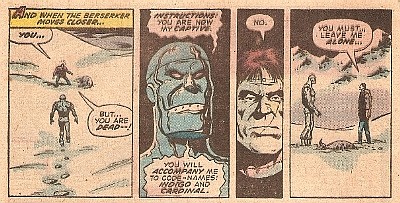 |
|
Meanwhile, the Monster has
detected the body of a dead mountain cow, already
frozen for a long time and partly covered by the
drifting snow, and the sight makes the Monster
ponder and reflect upon such things as death for
a lenghty period of time - enough for the
Berserker to catch up with his target. As the two
towering figures - one flesh and bone, the other
all metal and wires - see eye to eye, the android
orders the Monster to accompany him to the
I.C.O.N. base. The Monster, however, has no
intentions of following these instructions, and a
fierce fight breaks out, fuelled by growing rage
on one side and the cool precision of a machine
on the other. |
|
| |
| However,
the onslaught is brought to an abrupt halt when the
Monster rips off one of the android's arms and, feeling a
surge of sympathy for his "injured" opponent,
ceases to lash out at the Berserker and voices concern
about the damage he has inflicted. |
| |
| This outpouring of empathy by
the Monster and simple key words like "pain"
and "life" cause the
Berserker's programming to crash, and the android
too becomes peaceful and begins to gain self
control over his actions - or, as I.C.O.N.
operative Indigo, who is monitoring the events,
concludes with growing concern: the shock of the
inflicted damage on the electronic circuits must
have restored the self-will of the human mind
entrapped in the metal casing of the Berserker... |
|
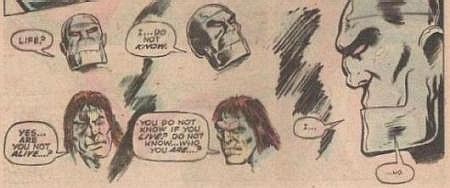 |
|
| |
| The
end result is two bewildered behemoths, uncertain about
their future just as they are uncertain about their place
in this world, walking off together into the wilderness
of the foothills of the Swiss Alps. More information on the entire series
is available here:
Marvel's
Monster Mash: Marvel's Bronze Age struggle with the
Frankenstein Monster
|
| |
| FRANKENSTEIN MONSTER
#17 IN CONTEXT |
| |
| When Frankenstein
Monster #17 went on sale in April 1975 with a cover
date of July 1975, it was a comic book which in some ways
echoed Kipling's The Last of the Light Brigade,
for here was one of Marvel's horror genre titles which
had started out with acclaim and applause but then found
itself virtually starving whilst still hoping for a "to
be continued" as it hovered on the brink of
cancellation. Born of the large scale return of the
horror genre to comic books in the early 1970s, The
Frankenstein Monster was set up by Marvel to follow
in the footsteps of their two highly successful classic
horror adaptations Tomb of Dracula and Werewolf
by Night.
|
| |
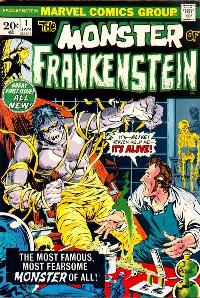
Monster of Frankenstein
#1 (January 1973)
|
|
Although conceived as another
"superhero
from the crypt",
i.e. taking established characters from the
horror genre and making them the protagonists of
their own ongoing titles, the Frankenstein
Monster was to start off on a distinctly
different route than Werewolf by Night
(which took the general mythology surrounding
werewolves only as a backbone for an otherwise
completely new plot and characters) and Tomb
of Dracula (where Bram Stoker's literary
heritage was acknowledged through the presence of
characters from the novel but the general plot
was rooted in the present timeframe and thus
clearly detached from the literary source). This
time, editor-in-chief Roy Thomas
insisted that the title should start
out with an adaptation of the literary source
(Cooke, 2001), and the first four issues of The
Monster of Frankenstein (as the series was
originally titled) thus presented what turned out
to be one of the most faithful renditions of Mary
Shelley's novel in 20th century popular culture. But what
looked like an excellent start for the title very
quickly turned out to be a huge burden. First
off, the successful adaptation put assigned
writer Gary Friedrich and artist Mike Ploog in a
position of having to literally continue Mary
Shelley's novel - a very tall order even for an
experienced comic book author such as Friedrich,
who was 30 at the time and had just co-created
Ghost Rider a few months earlier.
|
|
| |
| Ironically,
the second fundamental problem of the series was the
result of Friedrich's attempt to fix the first dilemma
and come up with a sensible sequel to the literary source
material. Friedrich connected the original comic book
plot to the end of the novel (where the monster bids
farewell to the explorer Sir Robert Walton somewhere in
the vast emptiness of the Arctic Sea and then drifts out
of sight) by choosing the same locale and introducing
readers to the explorer's great-grandson, Robert Walton
IV who has just found the Monster frozen in a block of
ice. With this framework for the adaptation (as Walton IV
retells the classic tale from Shelley’s novel to a
young midshipman) Friedrich opted for a period timeframe
and chose the year 1898. Whilst this was fine for the
adaptation, it quickly proved to be a dead end for
Friedrich and Ploog (who also did some plotting) as they
struggled to find a truly working concept for the
monster's story beyond the novel. The range of late
19th century original storyline options simply turned out
to be extremely limited, and Frankenstein Monster almost
immediately became a highly unbalanced comic book stuck
in a completely alien time frame for Marvel and devoid of
any clear storytelling direction.
|
| |
| Caught in a downward spiral,
Friedrich and editorial began to move away
sharply from Shelley's characterization of the
Monster and depicted Frankenstein's creation as a
violent and mindless brute which even lost its
ability to speak after a fight with a vampire
damaged its vocal chords. Friedrich had thus
turned the Monster into what Boris Karloff had
called an "oafish prop"
(Jones, 1995) when he had to play a mute
Monster in Universal's 1939 movie Son of
Frankenstein and thereafter quit the role
because he felt that such a degraded monster left
little room for development. In a last
attempt to salvage the series, Marvel had called
in Doug Moench (26 at the time and the main
author for Marvel's black and white magazines) to
replace Friedrich as of the September 1974
production of Frankenstein Monster #12.
The idea was to transfer the Monster from 1898 to
the present day timeframe, and Moench
accomplished the task in a no-fuss way which
worked well with the artwork from the also newly
assigned penciller, 24-year old Val Mayerik. By
the time issue #17 rolled around, Moench had
fixed the title's most troubling weaknesses by
introducing and establishing a regular supporting
cast, setting up sorely needed
story interest through a mysterious "bad guy
organisation" called I.C.O.N. (International
Crime Organization Nexus),
turning up the overall plot speed, and adding
more background credibility as he sent the
Monster back from NYC to the Swiss Alps.
|
|
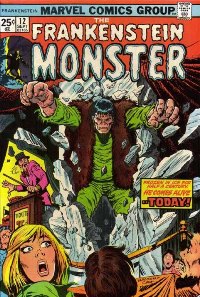
Monster of Frankenstein
#12 (September 1974)
|
|
| |
| The
resulting story arc in Frankenstein Monster #16-17
was undoubtedly the strongest of the title's run, but
Moench and Mayerik were up against a problem rooted in
the title's past which virtually precluded securing a
successful continuation - the pronounced and deep
division among its readership with regard to the title's
timeframe setting. |
| |
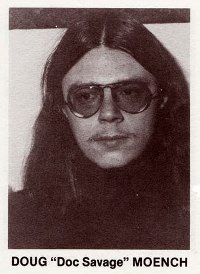
Doug Moench in an official
1975 Marvel picture
|
|
According to Marvel's own
analysis, the 1970s setting found pronounced
approval with two thirds of the readers but at
the same time alienated the remaing third. The
damage caused by initially starting out in 1898
was significant for a title which was already
dragging along in bi-monthly publication and thus
had a hard time attracting new readers to replace
those who dropped out. Things were
also hampered by Marvel's somewhat lukewarm
handling of the newly gained possibilities once
the Monster had gone from a Marvel character in
its "own world" to one which could
potentially interact with the Marvel Universe at
large. This option, however, was limited to
appearances in Giant-Size Werewolf by Night
#2 (October 1974) and The
Avengers #131-132 (January - February 1975),
and as both these storylines were quite detached
from the main title's ongoing plot they did
little to nothing to push Frankenstein
Monster in any way.
It is tempting to imagine,
for a second or two, a character such as Dr Doom
appearing in the Swiss Alps... but unfortunately,
editorial could not.
|
|
| |
| Nowhere did
the rift in the title's readership become more apparent
than in the letters pages, which had originally been
called Monster's Mailbox before being renamed Let's
be Frank! |
| |
| This new heading sounded
rather appropriate for the critcism which more
often than not raged in this readers' forum - it
almost seemed as though there was nothing short
of either loving the title or hating it. |
|

Click to read entire letters
page
|
|
| |
| The letters
page from Frankenstein Monster #17 depicts this
is an especially pronounced way as it contains very
little positive feedback in contrast to a wave of sharp
criticism. All of this, however, was in stark contrast to
the comments which would be published on the letters page
of Monster of Frankenstein #18, which would
overall lament the previous decline of the title but
praise the upward turn Moench had produced with issue
#16. But by that time, it was already too late. By mid-1975, Marvel
had lost $2 million and found itself in bad financial
shape. In response to this financial crisis, Marvel's
owner Cadence installed a new company president who
immediatley proceeded to cut down the number of titles
produced. As a result, Marvel's range of horror titles
almost collapsed: by the time the autumn production run
preparations were due, the fate of many Marvel horror
title was sealed, and the number of Marvel's horror
comics went down from 19 to 9. The first high-profile
victim - by name and popular culture status - of this
1975 horror genre cancellation wave was The
Frankenstein Monster. After 32 months and 18 issues,
it was the end of the road for the title in September
1975, and only one month later the Monster would be
followed by Man-Thing and the Mummy.
Sudden as the cancellation of the title appeared to be in
the end - taking place without announcement of any kind
and right in the midst of the storyline (usually, Marvel
tried to wrap up things in such cases) - it could not
have come as a surprise, given the fact that Moench was
transferred to other titles after issue #17 and the
plotting for what turned out to be the final issue handed
to Bill Mantlo - Marvel's "fill-in king" of the
late 1970s and an obvious case of a free writer with
nothing to lose on a title bound for limbo. In this case,
Mantlo's assignment lasted for one single issue before
the final curtain fell on The Frankenstein Monster.
|
| |
|
| |
| Having
filled Monster of Frankenstein #16 right up to
the brim with action and plot interest, Doug Moench
successfully continued his multi-layer approach in Frankenstein
Monster #17, and what this issue lacked in terms of
storytelling pace as compared to the previous issue it
more than made up with in terms of characterization and
plot development. Moench continued his mission to bring
the title back into line with its literary roots as the
whole underlying dilemma of the Frankenstein story once
again started to unfold - only that now it included the
Monster again, which through its regained ability to
speak returned to being the focal point of the story. |
| |
| On the metastory level of
character development, Moench instantly took
advantage of the Monster's return to speech and
the end of silence after 7 issues and 14 months
(which was even heralded in a blur on the cover
of Frankenstein Monster #17 - "Because
you demanded it -- the Monster speaks!"),
and depicted the Monster's thoughts as centering
quintessentially on the question of its identity,
and its opening lines on the splash page
immediately redefined the Monster. It
was no longer the lumbering, mindless heap of
flesh whose sole driving force is to wreak
bloodshed and revenge upon the descendants of its
creator, but rather an essentially human being
faced with complete uncertainty - and before it
can come to terms with anything, the Monster,
like all human beings, needs to know and
understand its roots - its true identity.
|
|
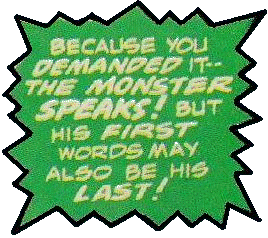 |
|
| |
| Moench
was now firmly in command of a plot which clearly
reflected on the story from a perspective very close to
Mary Shelley's. At the same time, Moench added new
elements from the modern setting which actually worked
and provided increased plot value and story interest. It
was a long way from some of those awkward twists and
turns which had plagued some earlier issues of Frankenstein
Monster, and it was done in the same swift but
determined way which Moench had displayed in transferring
the Monster to the present timeframe. Frankenstein
Monster #17 thus continued the action-driven
liveliness set by the previous issue (and which had been
sorely lacking throughout many issues of the series
before) in spite of also featuring some rather heavy
philosophical issues.
|
| |
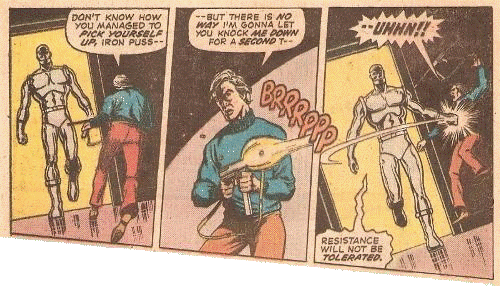 |
|
But it worked, and not the
least because I.C.O.N. kept adding speed and zap
in the same tongue-in-cheek fun tradition which
make Nick Fury's S.H.I.E.L.D. or James Bond's
SPECTRE so effective as plot tools. Most
of all, I.C.O.N.'s android Berserker
(what a great codename to contrast with Indigo,
Cardinal and, above all, Rainbow)
provided a credible antagonist for the Monster -
and a persistent problem for the group of
supporting cast regulars trapped in the
Frankenstein residence which kept them busy and
added the necessary momentum to the overall
storyline.
|
|
| |
| However,
central to this issue is Moench's step of bringing back the
drama of the Frankenstein theme by asking the same
quintessential questions raised by Shelley's novel: is
Frankenstein just a misguided scientist who actually
means good, or is he a madman, a megalomaniac who sees
himself as God? And where, most importantly, does his
creation take its place in life - if at all? If it is not
a monster - does that make it a human being, or just
something else? |
| |
|
| |
Left: Original art for The
Frankenstein Monster #17 (July 1975) pencilled
by Val Mayerik, inked by Bob McLeod and lettered by
Artie Simek (scanned from the original in my
personal collection).
Right: the same page as it appeared in print (colours
by Don Warfield). [click for larger
images]
|
| |
| It
is at this point that the series reached its best in
terms of the depth of original storytelling and plot
handling, and Mayerik's art throughout these pages is
amongst his best on the title as he depicts the white-out
of the Monster's thoughts and feelings in a similiar
surrounding. Doug Moench had been working with Val
Mayerik at
the time, and when he took over Frankenstein Monster
asked Mayerik if he would be interested in joining him on
that book. Mayerik's enthusiasm showed in his artwork,
and his style soon fused with Moench's writing to form a
distinctive rendition of the Frankenstein theme for
Marvel, including the Monster's appearance itself.
|
| |
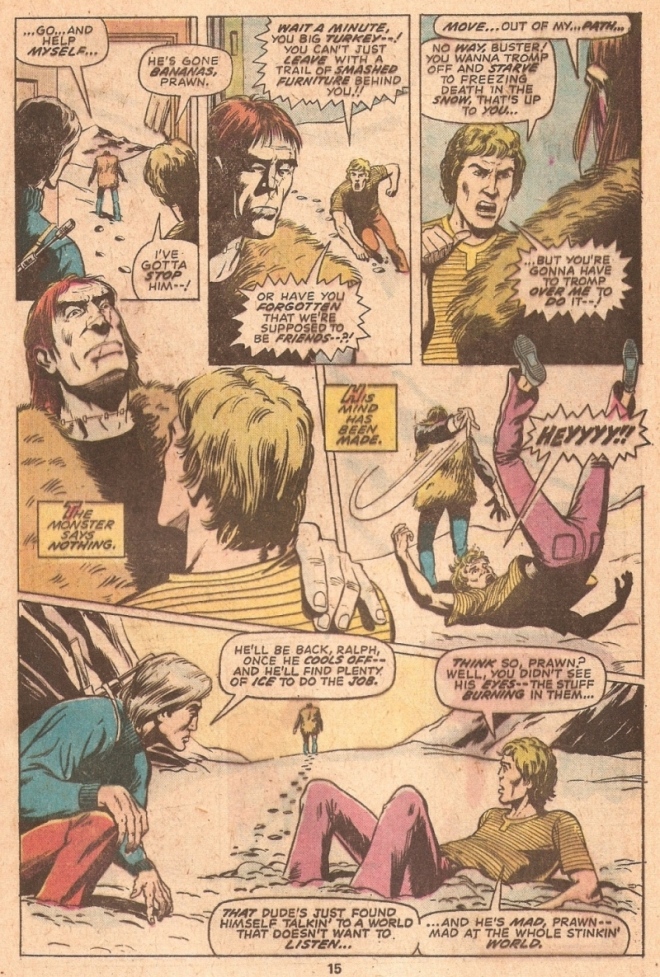
(click to view larger image)
|
|
In Frankenstein
Monster #17, Mayerik's artwork renders both
Moench's dynamic and ponderous plot in fitting
visualisations. One example is the
page layout shown here, where staggered and
slanted panels form visual equations of the
perturbed context, and key elements of the
storytelling are drawn to protrude out of their
actual panel, such as the head of the Monster,
the flying feet of Caccone, or the word balloons
of the bottom panel - all adding speed and depth
to the artwork.
20th century popular culture
has established a strong relationship between the
human mind and the human brain in the context of
the Frankenstein theme, mostly ignoring the fact
that this topic is a century-old matter of
philosophical and scientific debate (Smart,
2007).
As a consequence, much of
what is commonly referred to as identity is
therefore associated with the brain - which in
turn raises the intriguing question also brought
up by Doug Moench in Frankenstein Monster #17:
whose brain was brought back to life by Victor
Frankenstein inside the Monster's skull?
|
|
| |
| The
question had been raised before in the letters pages of Frankenstein
Monster, but somewhat surprisingly Moench closed the
lid on this almost immediately after he opened the
subject by immediately having Veronica Frankenstein
inform Caccone, Prawn and the Monster that all of Victor
Frankenstein's notes have been lost over time. |
| |
| This handling of the
"brain question" was in sharp contrast
to previous pop culture interpretations of this
aspect of the Frankenstein saga (the seeds of
which were sown in the 1931 Karloff movie where the Monster
is given a defective brain due to the bungling of
Frankenstein’s assistant), but actually in
sync with the original novel, where Shelley
alludes to how Frankenstein got hold of some of
the body parts, but never mentions the brain
specifically. |
|
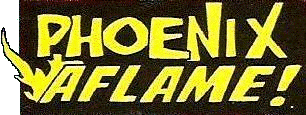 |
|
| |
"Who
shall conceive the horrors of my secret toil as I
dabbled among the unhallowed damps of the grave (...)
I collected bones from charnel-houses and disturbed,
with profane fingers, the tremendous secrets of the
human frame (...) The dissecting room and the
slaughter-house furnished many of my materials."
(Mary Shelley (1831), Frankenstein,
Chapter Four)
The
underlying reason for Universal's 1931 portrayal of the
bungling lab assistant’s accidental acquisition of a
defective brain was, of course, to present this as the
cause of the monster’s malevolence and socially
disturbing behaviour. However, this completely reverses
the central theme of the book, where Frankenstein's
creature starts out in life with the full potential for
good but is essentially twisted into evil by an unjust
and unwelcoming society. Shelley made it clear that she
felt that the social milieu has an important
impact on character, and her novel strongly suggests that
criminality and violence are to be understood as the
result of unhealthy societies - not defective brains or,
to update the concept, "bad genes".
The source
of the monster’s perceived evil nature is indeed one
of the central themes of the Frankenstein novel, but the
adaptations of Shelley's work in popular culture
effectively did away with this. It is therefore all the
more astonishing that a comic adaptation working with
original plot material would actually turn its focus to
exactly these questions - but that's just what Doug
Moench did in Frankenstein Monster #17.
|
| |

Berserker
redux as a typo sneaks into a cover blurb
|
|
In adressing the brain
question with the answer that all records of
Victor Frankenstein have been lost, Moench
provides the readers of the comic book with
basically the same amount of information - namely
none - given by Shelly to the reader of the
novel. It is admittedly a subtle way of telling
the readers that this question really is of
secondary (if any) importance, but it is followed
up by a Monster whose words and thoughts display
a sensitivity and depth not associated with a
"man-brute" - as one of the blurbs on
the cover screams out virtually in contradiction
to the contents of the issue. |
|
| |
| However,
the amount of thought and consideration invested by
Moench into bringing the Monster closer to its literary
essentials was not to be rewarded. The creative team had
managed to counteract the downward spiral the title had
found itself in for so long, but it was not enough to
save the book in a time when Marvel itself was in a deep
crisis. |
| |
| And so, Moench
wrapped up his writing, and fittingly
enough the last panel on the last page of
Frankenstein Monster #17 carries
the caption "FIN",
even though this issue would only be the
penultimate and not the final one. But
the book did end there for Moench, who
brought his plot and storyline to a point
which culminated in a last scene which
equalled many Hollywood closing takes in
the tradition of Casablanca when
the Monster and the Berserker walk away
from the reader and off into the
distance, "a man who is no
longer a monster... and a machine who is
no longer mindless". With
this final take on the Monster, Frankenstein
Monster #17 almost also becomes the de
facto ending for the title itself as
Moench's replacement Bill Mantlo
immediately steered away from any
closeness to Shelley and virtually wrote
issue #18 as though it came from a
different series.
|
|
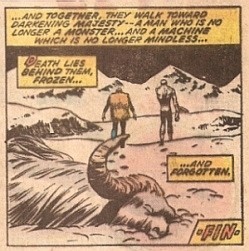 |
|
|

